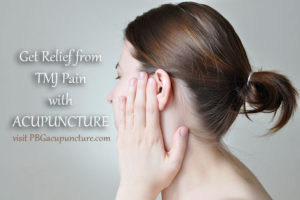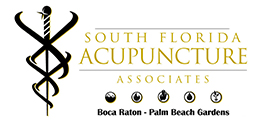 By Matthew Enright AP (Lic. AP1711) – Palm Beach Gardens, Florida – Acupuncture and TMJ – The temporomandibular joint’s function is to connect the jaw to the skull and the front of the ear at the temporal bones. The joint is responsible for mandibular movement which allows for yawning, chewing, talking and such mouth activity.
By Matthew Enright AP (Lic. AP1711) – Palm Beach Gardens, Florida – Acupuncture and TMJ – The temporomandibular joint’s function is to connect the jaw to the skull and the front of the ear at the temporal bones. The joint is responsible for mandibular movement which allows for yawning, chewing, talking and such mouth activity.
Temporomandibular joint disease (TMJ or TMD) is one term representing various conditions that affect the jaw. These problems include morphological and functional deformities as well as musculoskeletal conditions. When affected by the condition, a person may experience pain at the jaw when moving the mouth or be unable to move the mouth as freely as they are used to.
Nilner et al. (1981) explained in their research how TMD affects all types of patients from both genders and at all ages. Symptoms of the disease are wide-ranging and often make it hard to diagnose. Even in the same patient, the symptoms might change from time to time.
33% of the American population exhibits at least one symptom of the condition. Okeson JP (2008) also showed that 3.6% to 7% of these patients experience such severe symptoms that they seek medical advice. Other findings have shown that the disease is connected to emotional factors such as low self-esteem Manfredini D et al. (2003).
Fortunately acupuncture has been shown to be an effective treatment for TMJ. At our Palm Beach Gardens Acupuncture location we have resolved many a case of TMJ over the years, allowing our patients to become symptom free. Before we delve more into how acupuncture works for TMJ let us look at some of the causes, symptoms and conventional treatments of this condition.
Causes of TMD
The causes have been elusive in the years that the condition has been studied. However, occlusion changes have been cited as being part of the reason. Changes such as cross bite, open bite, occlusal interferences, midline discrepancies, missing and crowded teeth (Poveda Roda R et al.2007). Actions that stress the joint such as gum chewing, bruxism, teeth clenching, nail biting and biting foreign objects are some of the reasons for the development of the condition. (Magnusson T et al. 2005)
Tendencies of this kind usually don’t cause any effect unless they exert excessive pressure on the joint thus weakening structure and tolerance. Bruxism and clenching are parafunctional activities that cause joint reduction thus leading to pain in the muscles. Anxiety and depression were also named as reasons for the development of TMD (Ferrado M et al.2004)
Symptoms of the condition
TMD causes different types of pain. Generally, the pain is felt at the prearicular area, frontal temoralis muscle, masseter muscle regions. Patients describe the pain as being a burning sensation, pressure or an ache or all combined. The pain gets worse when the patient chews or clenches the jaw and is reduced by heating up the affected region of the mouth. Analgesics bought over the counter or relaxing the muscles affected will also reduce the pain. TMD pain comes is waves and (when it gets worse) feels like a throbbing sensation.
This pain is the main reason patients seek medical help. The pain is chronic and localized. Patients report that the pain is accompanied by headaches and earaches.
TMD is also associated with aural symptoms even though it still remains unclear why such symptoms appear. The symptoms include;
- Otalgia
- Tinnitus
- A sensation of otic fullness
- Hypoacousia
- Vertigo or dizziness
- Hyperacousia
Western medical treatments for TMD
TMD is a musculoskeletal condition which is treated as such. Occlusal orthotics, which are basically splints, are commonly used to cover the occlusal surface to prevent the patient from clenching. The splint can be made to the patient’s specifications regarding material and texture. A splint is not popular with a lot of the patients because it makes it difficult to talk and looks awkward when worn in public areas. Most patients wear it mostly when going to bed and only some few hours of the day.
Research showing acupuncture as a viable treatment mode
Wen Long-Hu et al. (2014) carried out research that showed laser acupuncture as a practical mode of treatment for the reduction of pain associated with TMD. It is a non-invasive technique which applies non-thermal, low-intensity laser to stimulate acupuncture points. Subjects that took part in the study went through a month-long treatment of 3 acupuncture therapies per week. The participants recorded reduction of pain after the treatment period.
A study carried out by Jun-Yi Wu et al. (2017) was based on other research studies on acupuncture. The study showed indicated that invasive acupuncture where needles are stuck beneath the skin shows more effective results than laser or sham acupuncture. Acupuncture was effectively shown to reduce myofascial symptoms.
Mario Vicente-Barrero et al. (2012) also carried out a study to demonstrate the application of splints and acupuncture to reduce pain as well as other symptoms. The study ran for 5 weeks and showed significant reduction of myofascial pain. It also showed reduced pain in localized areas such as the trapezius, temporal and masseter muscles.
There is a lot more research going on about the efficacy of acupuncture in the treatment of TMD. Many of the already published research studies show that acupuncture is a practical treatment for the condition.
At Palm Beach Gardens Acupuncture, we want to help you feel better. Call us today and receive the best treatment and a free consultation from the experienced acupuncture physicians in this Palm Beach Gardens location. We are confident we can help you.
References –
- Jun-Yi Wu, MD, Chao Zhang, MD, Yang-Peng Xu, MM, Ya-Yu Yu, MD, Le Peng, PhD, Wei-Dong Leng, PhD, Yu-Ming Niu, PhD, and Mo-Hong Deng, PhD 2017. Acupuncture therapy in the management of the clinical outcomes for temporomandibular disorders.
- Mario Vicente-Barrero, Si-Lei Yu-Lu, Bingxin Zhang, Sacramento Bocanegra-Pérez, David Durán-Moreno, Adriana López-Márquez, Milan Knezevic, José-María Castellano-Navarro, and José-María Limiñana-Cañal 2012.The efficacy of acupuncture and decompression splints in the treatment of temporomandibular joint pain-dysfunction syndrome.
- Wright EF. Otologic symptom improvement through TMD therapy. Quintessence Int. 2007;38(9):e564–71.
- Wen-Long Hu, Chih-Hao Chang, Yu-Chiang Hung, Ying-Jung Tseng, I-Ling Hung, Sheng-Feng Hsu, and Jan P. A. Baak.2014. Laser Acupuncture Therapy in Patients with Treatment-Resistant Temporomandibular Disorders.
- Web MD
- Magnusson T, Egermarki I, Carlsson GE. A prospective investigation over two decades on signs and symptoms of temporomandibular disorders and associated variables. A final summary. Acta Odontol Scand. 2005;63:99–109.
